Exploring the 7 Different Types of Data Stories
Exploring the 7 Different Types of Data Stories
What makes a story truly data-driven? For one, the numbers aren’t caged in a sidebar graph. Instead, the data helps drive the narrative.
Data can help narrate as many types of stories as there are angles. My colleague Ben Jones ofTableau Public inspired me to think of data stories as seven different types (à la Christopher Booker’s seven basic story plots). Jones based his idea on analysis of numerous data stories, and his framework helps imagine ways to free data from sidebar graphs. These categories are meant to be a thought-starter, not a final count, which is sure to be higher.
Let’s explore each category using data compiled by Freedom House, an independent watchdog organization. The data ranks each country as “free,” “partly free,” or “not free,” based on a score. Using this simple dataset, we can tell seven different stories. The angle depends on what you want the data to show and how you plan to show it.
1. NARRATE CHANGE OVER TIME
How many countries were categorized as “free” in 2013 versus in 2001? It turns out the number shrank over time. We can use the data to visualize the change, then explain the forces at work.
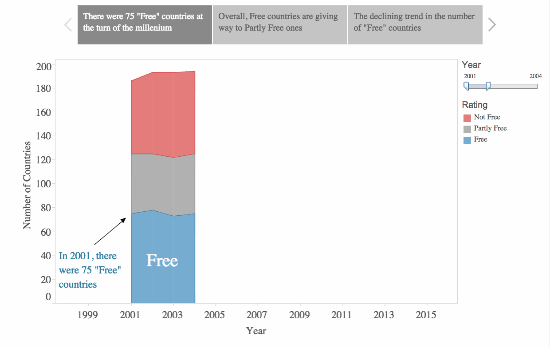
Credit: Ben Jones.
CNBC’s John Schoen took this approach to visualize the history of the Dow 30 over 87 years. The user can click on each decade and see how the index reacted to the tech boom, the inflation of the ‘70s, even the Great Depression. The CNBC staff paired the visualization with future forecastsbased on past trends.

The History of the Dow 30. John Schoen
Click to visit the full interactive visualization.
2. START BIG AND DRILL DOWN
Data can guide the reader from the big-picture view down to a focused view. Using the Freedom House data, start the reader with a world map of the scores, the big view. Then the reader can zoom in on a region — Asia, say — and see that more than half of the countries there are labeled as “not free.” Zoom in even more, and the reader sees that North Korea is the least free country of all.
We can guide the reader through this sequence by providing prompts in the copy as well as interactive filters.
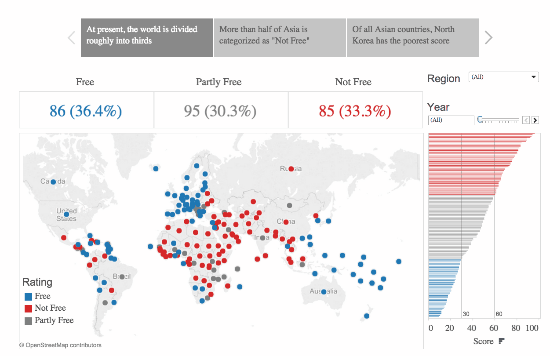
Credit: Ben Jones.
The example below shows vaccine-preventable outbreaks recorded around the world. The overview shows how many such cases exist. The filters allow the reader to drill down by country, disease, or year. The reader might be guided to see, for example, that whooping cough is more prevalent in the U.S. than elsewhere, and the story can outline the possible reasons why.

Vaccine-Preventable Outbreaks. Credit: CFR
Click to visit the full interactive visualization.
3. START SMALL AND ZOOM OUT
We can also do the reverse by starting with the molecular view and expanding to the larger view. For example, first focus on the three freest countries in the world, which happen to be clustered in Europe. From there, zoom out the narrative to show how other European countries stack up, then zoom out again to show the global comparison. Then the reader sees that just over one-third of all countries are labeled as “free.”
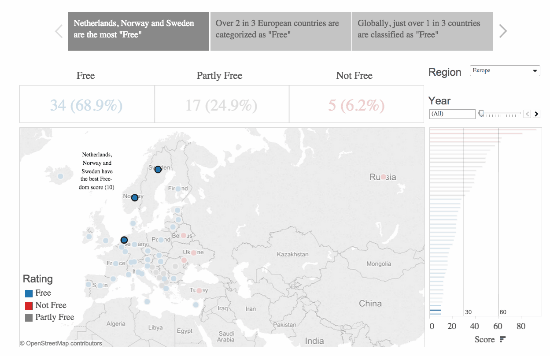
Credit: Ben Jones.
Here’s an example that looks at the impact of immigration on housing value. The reader can enter his or her zip code to start with a hyperlocal view. The interactive filter provides the statewide view, and the map overview gives the national perspective.

Immigrants and Housing. Credit: Jacob Vigdor
Click to visit the full interactive visualization.
4. HIGHLIGHT CONTRASTS
Outlining the differences in datasets can drive a powerful narrative. The 10 freest countries are all in Europe, and happen to be located close together. The 10 least free countries, on the other hand, are in five different regions.
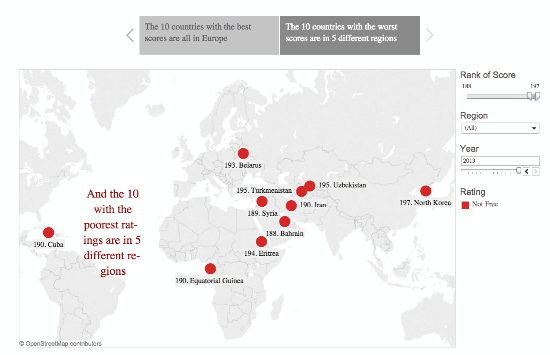
Credit: Ben Jones.
Of course, geography is just one of the two groups’ many differences. Our story can explore the key ways in which the two groups differ, from government policies to culture to history. A study of contrasts could make for a captivating piece.
We can tell a similar story with the example below. It compares the gender gap in countries around the world based on three dimensions of human development: a long and healthy life, knowledge, and a decent standard of living. Countries on one end of the spectrum have large disparities while those on the other end have near-equality.

HDI Gender Gap. Credit: Ramon Martinez
Click to visit the full interactive visualization.
5. EXPLORE THE INTERSECTION
When two divergent lines of data intersect and one overtakes the other, questions result. The freedom data shows that the number of “partly free” countries overtake the “not free” countries, then go on to also surge past the “free” countries. What caused the shift? When standings change, people want to know the reason.
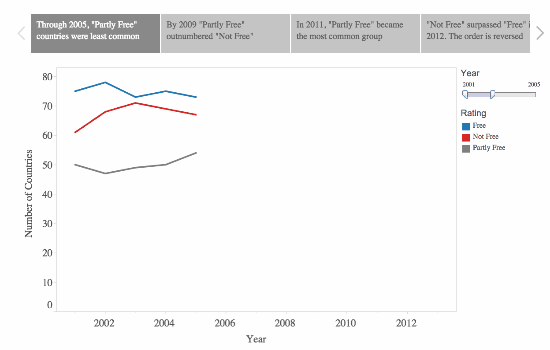
Credit: Ben Jones.
Sarah Ryley of New York Daily News visualized the number of summonses issued in New York since broken-windows policing took effect in 1993. The number rose sharply at first and held steady before starting a slow decline. Then a spike in stop-and-frisks led to an intersection with summonses in 2010. Granted, the two lines don’t compare apples to apples. However, the crossing and its components can drive a narrative about New York’s law enforcement strategy.

Summonses Since ‘Broken Windows.’ Credit: Sarah Ryley
Click to visit the full interactive visualizaton.
6. DISSECT THE FACTORS
Sometimes factors come together like pieces of a puzzle to form the big picture. The relationship might be additive or multiplicative. For example, each country’s freedom score is the sum of legal, economic and political freedom.
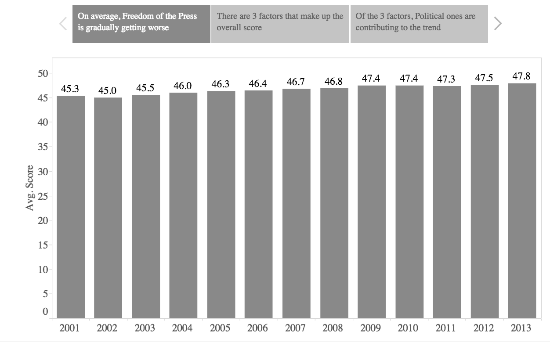
Credit: Ben Jones.
Here’s an example that shows how the sun controls the weather. The visualization draws the dot from sunspots to global weather, highlighting causal relationships along the way.

Sunspots. Credit: Matt Francis.
Click to visit the full interactive visualization.
7. PROFILE THE OUTLIERS
We are fascinated by things that aren’t like the others. We want to know the why and the how behind the outliers.
Finding the outliers sometimes takes a bit of data exploration. Visualize the freedom data as a scatterplot, and you might say there is no outlier. But break it down by regions in a box plot, and you start to see those that stand apart.
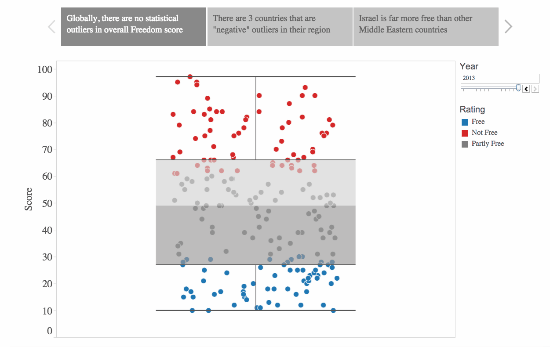
Credit: Ben Jones.
This example shows the number of government requests Facebook received in the first half of 2013. The map makes it clear that the U.S. is the clear outlier with a margin of more than 8,200 requests. An accompanying story could highlight the U.S. government’s stance on social media monitoring, main use cases, and possible reasons for the feds’ unusually high number of requests.

Facebook’s Government Requests. Credit: Andy Kriebel
Click to visit the full interactive visualization.
OTHER STORY TYPES?
We just explored the beginnings of seven different story types using one simple dataset. But as I mentioned, these categories are intended as a thought-starter. So what other types of stories should we add to this list? How else can we use data to tell stories? Share your ideas in the comments below.
Correction: This post has been updated to correct credits on the visualizations.
Martha Kang is the editorial manager of Tableau Software where she helps chronicle today’s big data revolution. A lifelong storyteller, she’s currently focused on telling data-driven stories that help us better understand our world, and ultimately, ourselves. Prior to joining Tableau, Martha worked as a journalist, first in TV news then in new media. She most recently served as the online managing editor of KPLU, an NPR affiliate in Seattle. There, she oversaw a number of projects, including the launch of Quirksee.org, a vertical site that featured two of her own award-winning stories, as well as a five-part, data-driven series, on Washington state’s idiosyncratic tax system.Martha has also worked at KOMO News, Northwest Cable News, and WLS-TV. In 2013, she was chosen as a Kiplinger fellow of public affairs journalism by Ohio State University.
Exploring the 7 Different Types of Data Stories的更多相关文章
- TYPES、DATA、TYPE、LIKE、CONSTANTS、STATICS、TABLES
声明:原创作品,转载时请注明文章来自SAP师太技术博客( 博/客/园www.cnblogs.com):www.cnblogs.com/jiangzhengjun,并以超链接形式标明文章原始出处,否则将 ...
- JavaScript data types and data structures
JavaScript data types and data structures Programming languages all have built-in data structures, b ...
- TYPES与DATA区别
例如:int a; "c语言定义 TYPES:BEGIN OF typ, filed1 TYPE c, END OF typ. "相当于int类型 DAT ...
- JAXB - XML Schema Types, Binary Data
Data that has no "natural" representation with printable characters must, for inclusion in ...
- ExtJS笔记 Ext.data.Types
This is a static class containing the system-supplied data types which may be given to a Field. Type ...
- Data Types
原地址: Home / Database / Oracle Database Online Documentation 11g Release 2 (11.2) / Database Administ ...
- Oracle Schema Objects——Tables——Oracle Data Types
Oracle Schema Objects Oracle Data Types 数据类型 Data Type Description NUMBER(P,S) Number value having a ...
- 关于powerdesigner中的data types说明
原文:关于powerdesigner中的data types说明 这一堆的数据类型看着真是头大,弄个表格对照一下. Numeric data types Standard datatype DBMS- ...
- Why Apache Spark is a Crossover Hit for Data Scientists [FWD]
Spark is a compelling multi-purpose platform for use cases that span investigative, as well as opera ...
随机推荐
- Ubuntu中wine安装的程序如何卸载
很多朋友尝试在Ubuntu中用wine安装exe格式的应用程序,但经常遇到装完之后启动程序就崩溃.或者根本无法启动.无法使用的情况,于是想立即把安装的程序卸载,可是在wine中却找不到卸载exe软件的 ...
- response小结(二)——文件下载
我们先来看一个最简单的文件下载的例子: package com.yyz.response; import java.io.FileInputStream; import java.io.IOExcep ...
- sql中nvarchar(max)长度测试
nvarchar(max)长度测试:在使用convert强制类型转化之后 文本长度可以突破8000的上限.并且nvarchar(max)的最大长度可达到2^31以下为验证SQL: Declare @A ...
- c# 中日期的使用
上月第一天:DateTime.Parse(DateTime.Now.AddMonths(-1).ToString("yyyy-MM-01")) 上周星期天:DateTime.Par ...
- android不依赖具体activity弹出Dialog对话框,即全局性对话框
最近在DialogUtil类中声明了一个静态的弹出Dialog方法,弹出的Dialog也是静态的,并且只在第一次进行创建,由于Dialog弹出依附于Activity,所以就出现了问题. 即:第一次调用 ...
- Linux 命令行技巧
这是一个linux常见命令的列表.那些有• 标记的条目,你可以直接拷贝到终端上而不需要任何修改,因此你最好开一个终端边读边剪切&拷贝.所有的命令已在Fedora和Ubuntu下做了测试 命令 ...
- UIView中常见的方法总结
addSubview: 添加一个子视图到接收者并让它在最上面显示出来.- (void)addSubview:(UIView *)view[讨论]这方法同样设置了接收者为下一个视图响应对象.接收者保留视 ...
- JQuery验证工具
一.写法一 var Validator = { // 邮箱isEmail : function(s) {var p = "^[-!#$%&\'*+\\./0-9=?A-Z^_`a-z ...
- ZigBee NV层使用
原文转载于http://www.cnblogs.com/yqh2007/archive/2011/05/31/2065284.html 系统NV区:初始化nv数据项 osal_nv_item_in ...
- 多文件上传 iOS功能
多文件上传 iOS功能,原文来自ios教程网整理的,大家可以看看演示:ios.662p.com ,喜欢的朋友可以看看我的博客吧. NSURL* url = [NSURL URLWithString:@ ...
